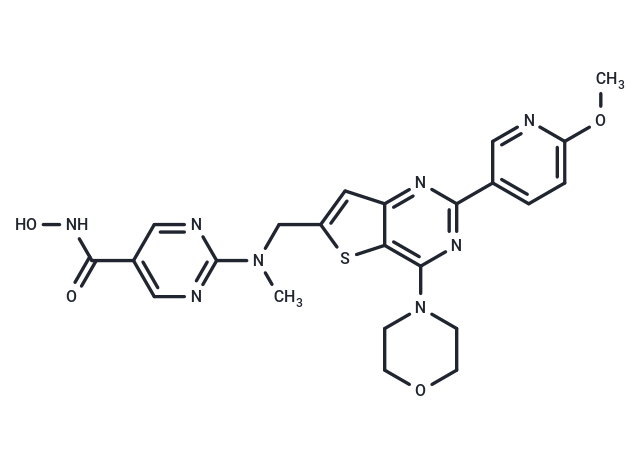Shopping Cart
- Remove All
 Your shopping cart is currently empty
Your shopping cart is currently empty

Fimepinostat (CUDC 907) is an orally bioavailable inhibitor of both phosphoinositide 3-kinase (PI3K) class I and pan-histone deacetylase (HDAC) enzymes, with potential antineoplastic activity. Upon oral administration, CUDC-907 inhibits the activity of both PI3K class I isoforms and HDAC, thereby preventing the activation of the PI3K-AKT-mTOR signal transduction pathway that is often overactivated in many cancer cell types.

| Pack Size | Price | Availability | Quantity |
|---|---|---|---|
| 2 mg | $39 | In Stock | |
| 5 mg | $64 | In Stock | |
| 10 mg | $98 | In Stock | |
| 25 mg | $185 | In Stock | |
| 50 mg | $328 | In Stock | |
| 100 mg | $538 | In Stock | |
| 500 mg | $1,150 | In Stock | |
| 1 mL x 10 mM (in DMSO) | $72 | In Stock |
| Description | Fimepinostat (CUDC 907) is an orally bioavailable inhibitor of both phosphoinositide 3-kinase (PI3K) class I and pan-histone deacetylase (HDAC) enzymes, with potential antineoplastic activity. Upon oral administration, CUDC-907 inhibits the activity of both PI3K class I isoforms and HDAC, thereby preventing the activation of the PI3K-AKT-mTOR signal transduction pathway that is often overactivated in many cancer cell types. |
| Targets&IC50 | HDAC2:5.0 nM, HDAC3:1.8 nM, HDAC11:5.4 nM, HDAC10:2.8 nM, HDAC1:1.7 nM |
| In vitro | In studies assessing the efficacy of NHL and MM models, CUDC-907, when administered at its maximum tolerated dose (MTD), demonstrated significantly greater effectiveness compared to either PI3K or HDAC inhibitors alone or their combination. Additionally, CUDC-907 exhibited superior efficacy over the PI3Kδ selective inhibitor CAL-101 at its MTD. It also displayed oral bioavailability in canine species and a longer half-life in murine tumor models. When targeting xenograft tumors, CUDC-907 induced apoptosis and inhibited cancer cell proliferation. |
| In vivo | CUDC-907 exhibits inhibitory effects on the growth of a range of B-cell lymphomas, as demonstrated by its IC50 values in various cell lines including Granta 519 (7 nM), DOHH2 (1 nM), RL (2 nM), Pfeiffer (4 nM), SuDHL4 (3 nM), Daudi (15 nM), and Raji (9 nM). Additionally, CUDC-907 blocks the proliferation of multiple myeloma cell lines such as RPMI8226 (2 nM), OPM-2 (1 nM), and ARH77 (5 nM), indicating its potent anticancer activity against both multiple myeloma and B-cell lymphomas. CUDC-907 also inhibits various PI3K isoforms, including PI3Kβ/γ/δ and PI3KαE545K, with IC50 values of 54, 311, 39, and 62 nM, respectively. Furthermore, it effectively inhibits HDAC isoforms HDAC1/2//6/11 with IC50 values of 191, 27, and 5.4 nM, respectively, plus exhibits mild inhibitory effects on other HDAC enzyme activities. |
| Kinase Assay | The activities of classes I and II HDACs are measured using the Color-de-Lys assay system. The activity of PI3K is measured using the ADP-Glo luminescent kinase assay. Recombinant PI3K protein, a complex of N-terminal GST-tagged recombinant full-length human p110 and untagged recombinant full-length human p85, is coexpressed in a baculovirus-infected Sf9 cell expression system[1]. |
| Cell Research | CUDC-907 is dissolved in DMSO and stored (-80°C), and then diluted with appropriate medium before use[1]. Human cancer cell lines are plated at densities of 5,000 to 10,000 per well in 96-well flat-bottomed plates with the recommended culture medium. The cells are then incubated with compounds (e.g.,CUDC-907) at various concentrations for 72 hours in culture medium supplemented with 0.5% (v/v) FBS. Growth inhibition is assessed by assay of cellular ATP content using the Perkin-Elmer ATPlite kit[1]. |
| Alias | PI3K/HDAC Inhibitor, CUDC-907, CUDC 907 |
| Molecular Weight | 508.55 |
| Formula | C23H24N8O4S |
| Cas No. | 1339928-25-4 |
| Smiles | COc1ccc(cn1)-c1nc(N2CCOCC2)c2sc(CN(C)c3ncc(cn3)C(=O)NO)cc2n1 |
| Relative Density. | 1.445 g/cm3 (Predicted) |
| Storage | Powder: -20°C for 3 years | In solvent: -80°C for 1 year | Shipping with blue ice. | |||||||||||||||||||||||||||||||||||
| Solubility Information | Ethanol: < 1 mg/mL (insoluble or slightly soluble) DMSO: 94 mg/mL (184.84 mM), Sonication is recommended. | |||||||||||||||||||||||||||||||||||
Solution Preparation Table | ||||||||||||||||||||||||||||||||||||
DMSO
| ||||||||||||||||||||||||||||||||||||

Copyright © 2015-2025 TargetMol Chemicals Inc. All Rights Reserved.